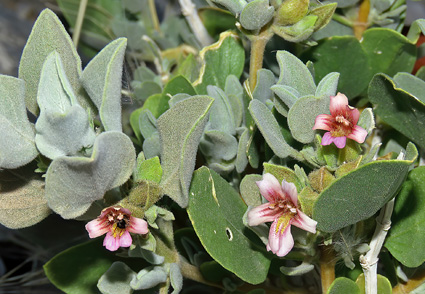Abstract
Petalidium sesfonteinense, previously most commonly confused with the widespread P. variabile, is here described as a new species. It is only known from the Sesfontein area in the Kaokoveld Centre of Endemism, northwestern Namibia, where it grows on hillsides and along ephemeral riverbeds. Diagnostic characters for P. sesfonteinense include the short, stout trunk on older plants, white bark that peels on the younger branches in long, narrow strips, dendritic trichomes on vegetative parts, flowers in short dichasia with acute oblanceolate bracts, flowers with externally glabrous corollas, corolla lobes that are pink, magenta, apricot or cream and with the two upper lobes connate towards the base and the lower lobe with two yellow spots near the base. A comparison of some of the more prominent morphological features to differentiate Petalidium sesfonteinense from close relatives is provided. Based on IUCN Red List categories and criteria, a conservation assessment of Least Concern (LC) is recommended for the new species.
References
<p>Clarke, C.B. (1899) <em>Petalidium</em>. <em>In</em>: Thiselton-Dyer, W.T. (Ed.) <em>Flora of Tropical Africa</em> 5 (1). L. Reeve & Co., London, pp. 87–93. [https://www.biodiversitylibrary.org/item/128#page/98/mode/1up]</p>
<p>Craven, P. (2009) <em>Phytogeographic study of the Kaokoveld Centre of Endemism</em>. Ph.D. Thesis. University of Stellenbosch, Stellenbosch, 234 pp. [https://hdl.handle.net/10019.1/1325]</p>
<p>Darbyshire, I., Kiel, C.A., Astroth, C.M., Dexter, K.G., Chase, F.M. & Tripp, E.A. (2020) Phylogenomic study of <em>Monechma</em> reveals two divergent plant lineages of ecological importance in the African savanna and succulent biomes. <em>Diversity</em> 12: a237 [25 pp.]. https://doi.org/10.3390/d12060237</p>
<p>Germishuizen, G. & Meyer, N.L. (Eds.) (2003) <em>Plants of southern Africa: an annotated checklist</em>. Strelitzia 14. National Botanical Institute, Pretoria, 1231 pp.</p>
<p>IUCN (2012) <em>IUCN red list categories and criteria</em>: Vers. 3.1. 2nd edn. Gland, Switzerland and Cambridge, U.K., iv + 32 pp.</p>
<p>Manktelow, M. (2000) The filament curtain: a structure important to systematics and pollination biology in the Acanthaceae. <em>Botanical Journal of the Linnean Society</em> 133: 129–160. https://doi.org/10.1006/bojl.1999.0309</p>
<p>Mendelsohn, J., Jarvis, A., Roberts, C. & Robertson, T. (2002) <em>Atlas of Namibia</em>. Philip, Cape Town, 200 pp.</p>
<p>Meyer, P.G. (1961) Beiträge zur kenntnis der Acanthaceen Südwestafrikas (III). <em>Mitteilungen der Botanischen Staatssammlung München</em> 4: 59–72. [https://www.biodiversitylibrary.org/item/52384#page/747/mode/1up]</p>
<p>Meyer, P.G. (1967) Beiträge zur kenntnis der Acanthaceen Südwestafrikas. <em>Mitteilungen der Botanischen Staatssammlung München</em> 6: 505–515. [https://www.biodiversitylibrary.org/item/51962#page/537/mode/1up]</p>
<p>Meyer, P.G. (1973) Neue und enig bekannte Acanthaceen aus dem Kaokoveld (Südwestafrika). <em>Mitteilungen der Botanischen Staatssammlung München</em> 11: 101–113. [https://www.biodiversitylibrary.org/item/51768#page/111/mode/1up]</p>
<p>Moore, S. (1880) Enumeratio Acanthacearum Herbarii Welwitschiani Angolensis. <em>Journal of Botany, British and Foreign</em> 18: 225–233. [https://www.biodiversitylibrary.org/item/108761#page/236/mode/1up]</p>
<p>Nees von Esenbeck, C.G. (1832) Acanthaceae India Orientalis. <em>In</em>: N. Wallich (Ed.) <em>Plantae Asiaticae rariores: or descriptions and figures of a select number of unpublished East Indian plants</em>, Vol. 3. Treuttel & Würtz, London, pp. 70–117. [https://www.biodiversitylibrary.org/item/9716#page/172/mode/1up]</p>
<p>Obermeijer, A.A. (1936) The South African species of <em>Petalidium. Annals of the Transvaal Museum</em> 18: 151–162.</p>
<p>Suessenguth, K. & Merxmüller, H. (1955) Taxa praecipue Africana. <em>Mitteilungen der Botanischen Staatssammlung München</em> 2: 67–83. [https://www.biodiversitylibrary.org/page/15187834#page/93/mode/1up]</p>
<p>Swanepoel, W. (2020) <em>Petalidium kaokoense </em>(Acanthaceae), a new species from Namibia. <em>Phytotaxa </em>468: 236–242. https://doi.org/10.11646/phytotaxa.468.3.1</p>
<p>Thiers, B. (2022) <em>Index Herbariorum: A global directory of public herbaria and associated staff</em>. New York Botanical Garden’s Virtual Herbarium. Available from: http://sweetgum.nybg.org/ih/ (accessed January 2022)</p>
<p>Tripp, E.A. & Dexter, K.G. (2012) Taxonomic novelties in Namibian <em>Ruellia </em>(Acanthaceae).<em> Systematic Botany</em> 37 (4): 1023–1030. https://doi.org/10.1600/036364412X656509</p>
<p>Tripp, E.A., Tsai, Y.E., Zhuang, Y. & Dexter, K.G. (2017) RADseq dataset with 90% missing data fully resolves recent radiation of <em>Petalidium </em>(Acanthaceae) in the ultra-arid deserts of Namibia. <em>Ecology and Evolution</em> 7: 1–17. https://doi.org/10.1002/ece3.3274</p>
<p>Van Wyk, A.E. & Smith, G.F. (2001) <em>Regions of floristic endemism in southern Africa: a review with emphasis on succulents</em>. Umdaus Press, Hatfield, Pretoria, 199 pp.</p>


